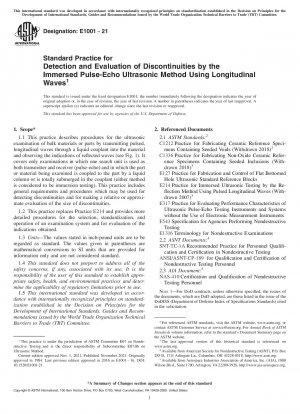ASTM E1001-21
Standard Practice for Detection and Evaluation of Discontinuities by the Immersed Pulse-Echo Ultrasonic Method Using Longitudinal Waves
- Standard No.
- ASTM E1001-21
- Release Date
- 2021
- Published By
- American Society for Testing and Materials (ASTM)
- Latest
- ASTM E1001-21
- Scope
- 1.1 This practice describes procedures for the ultrasonic examination of bulk materials or parts by transmitting pulsed, longitudinal waves through a liquid couplant into the material and observing the indications of reflected waves (see Fig. 1). It covers only examinations in which one search unit is used as both transmitter and receiver (pulse-echo) and in which the part or material being examined is coupled to the part by a liquid column or is totally submerged in the couplant (either method is considered to be immersion testing). This practice includes general requirements and procedures which may be used for detecting discontinuities and for making a relative or approximate evaluation of the size of discontinuities. 1.2 This practice replaces Practice E214 and provides more detailed procedures for the selection, standardization, and operation of an examination system and for evaluation of the indications obtained. 1.3 Units—The values stated in inch-pound units are to be regarded as standard. The values given in parentheses are mathematical conversions to SI units that are provided for information only and are not considered standard. 1.4 This standard does not purport to address all of the safety concerns, if any, associated with its use. It is the responsibility of the user of this standard to establish appropriate safety, health, and environmental practices and determine the applicability of regulatory limitations prior to use. 1.5 This international standard was developed in accordance with internationally recognized principles on standardization established in the Decision on Principles for the Development of International Standards, Guides and Recommendations issued by the World Trade Organization Technical Barriers to Trade (TBT) Committee.
ASTM E1001-21 Referenced Document
- ASTM C1212 Standard Practice for Fabricating Ceramic Reference Specimens Containing Seeded Voids
- ASTM C1336 Standard Practice for Fabricating Non-Oxide Ceramic Reference Specimens Containing Seeded Inclusions
- ASTM E127 Standard Practice for Fabricating and Checking Aluminum Alloy Ultrasonic Standard Reference Blocks
- ASTM E1316 Standard Terminology for Nondestructive Examinations*, 2024-02-01 Update
- ASTM E214 Standard Practice for Immersed Ultrasonic Examination by the Reflection Method Using Pulsed Longitudinal Waves
- ASTM E317 Standard Practice for Evaluating Performance Characteristics of Ultrasonic Pulse- Echo Examination Instruments and Systems Without the Use of Electronic Measurement Instruments
- ASTM E543 Standard Practice for Agencies Performing Nondestructive Testing
- ISO 9712 Non-destructive testing — Qualification and certification of NDT personnel*, 2021-12-21 Update
ASTM E1001-21 history
- 2021 ASTM E1001-21 Standard Practice for Detection and Evaluation of Discontinuities by the Immersed Pulse-Echo Ultrasonic Method Using Longitudinal Waves
- 2016 ASTM E1001-16 Standard Practice for Detection and Evaluation of Discontinuities by the Immersed Pulse-Echo Ultrasonic Method Using Longitudinal Waves
- 2011 ASTM E1001-11 Standard Practice for Detection and Evaluation of Discontinuities by the Immersed Pulse-Echo Ultrasonic Method Using Longitudinal Waves
- 2006 ASTM E1001-06 Standard Practice for Detection and Evaluation of Discontinuities by the Immersed Pulse-Echo Ultrasonic Method Using Longitudinal Waves
- 2004 ASTM E1001-04 Standard Practice for Detection and Evaluation of Discontinuities by the Immersed Pulse-Echo Ultrasonic Method Using Longitudinal Waves
- 1999 ASTM E1001-99a Standard Practice for Detection and Evaluation of Discontinuities by the Immersed Pulse-Echo Ultrasonic Method Using Longitudinal Waves
